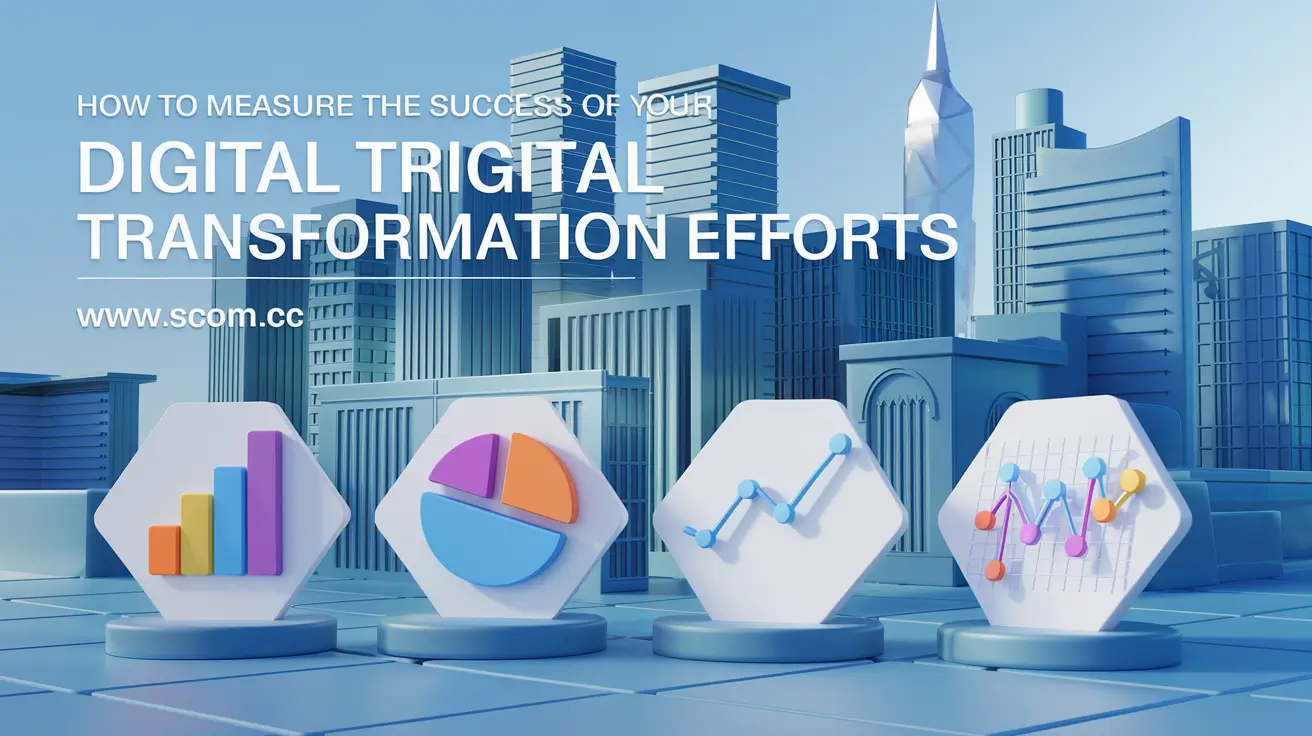How to Measure the Success of Your Digital Transformation Efforts

- How to Measure the Success of Your Digital Transformation Efforts
- Understanding Digital Transformation
- Key Metrics for Measuring Digital Transformation Success
- Methods for Measuring Digital Transformation Success
- Challenges in Measuring Digital Transformation Success
- Best Practices for Measuring Digital Transformation Success
- Summary Table
-
FAQ
- What are the key metrics for measuring the success of digital transformation?
- How can financial performance be used to measure digital transformation success?
- What methods can be used to measure customer experience in digital transformation?
- How can operational efficiency be evaluated in digital transformation?
- Why is employee engagement important in digital transformation?
- What are some challenges in measuring digital transformation success?
- How can best practices improve the measurement of digital transformation success?
How to Measure the Success of Your Digital Transformation Efforts
Digital transformation is a multifaceted process involving the integration of digital technologies into all areas of a business. Its goal is to fundamentally change how organizations operate and deliver value to customers. Measuring the success of digital transformation efforts is crucial to understanding their impact, optimizing strategies, and ensuring continuous improvement. This article explores the key metrics, methods, and best practices for assessing the success of digital transformation initiatives.
Understanding Digital Transformation
Digital transformation involves leveraging technology to enhance business processes, improve customer experiences, and create new business models. It encompasses various elements, including:
- Technology Integration: Implementing digital tools and platforms to streamline operations.
- Cultural Change: Shifting organizational culture to embrace innovation and agility.
- Process Optimization: Redesigning processes to be more efficient and effective.
- Customer Experience: Enhancing how customers interact with and perceive the business.
Key Metrics for Measuring Digital Transformation Success
Financial Performance
Financial metrics are essential for evaluating the impact of digital transformation on a company’s bottom line. Key financial indicators include:
- Revenue Growth: Analyze changes in revenue attributed to new digital channels, products, or services.
- Cost Reduction: Measure reductions in operational costs due to process automation or efficiency improvements.
- Return on Investment (ROI): Calculate the ROI of digital transformation initiatives by comparing the financial benefits with the costs of implementation.
Customer Experience
Improving customer experience is a primary goal of digital transformation. Metrics to assess customer experience include:
- Customer Satisfaction Scores: Use surveys and feedback tools to gauge customer satisfaction with digital interactions and services.
- Net Promoter Score (NPS): Measure customer loyalty and willingness to recommend your brand based on digital experiences.
- Customer Retention Rates: Track changes in customer retention and churn rates as a result of improved digital experiences.
Operational Efficiency
Digital transformation aims to enhance operational efficiency through process improvements and automation. Key operational metrics include:
- Process Cycle Time: Measure the time required to complete key business processes before and after digital transformation.
- Productivity Metrics: Evaluate changes in employee productivity and efficiency resulting from digital tools and automation.
- Error Rates: Track reductions in errors and defects due to improved processes and systems.
Employee Engagement
Engaging employees in the digital transformation process is crucial for its success. Metrics to assess employee engagement include:
- Employee Satisfaction Scores: Use surveys to measure employee satisfaction with digital tools and changes in work processes.
- Adoption Rates: Monitor the adoption rates of new digital tools and systems among employees.
- Training and Development: Assess the effectiveness of training programs designed to equip employees with the skills needed for digital transformation.
Innovation and Agility
Digital transformation fosters innovation and agility within organizations. Metrics to evaluate innovation and agility include:
- Time-to-Market: Measure the time required to develop and launch new products or services.
- Number of Innovations: Track the number of new products, features, or business models introduced as a result of digital initiatives.
- Change Readiness: Assess the organization’s ability to adapt to new technologies and market changes.
Methods for Measuring Digital Transformation Success
Benchmarking
Benchmarking involves comparing your organization’s digital transformation performance against industry standards or competitors. Key steps include:
- Identify Metrics: Determine relevant metrics for benchmarking, such as financial performance, customer experience, and operational efficiency.
- Collect Data: Gather data on your organization’s performance and compare it with industry benchmarks or competitor data.
- Analyze Results: Analyze the results to identify areas of strength and opportunities for improvement.
Surveys and Feedback
Surveys and feedback tools provide valuable insights into the impact of digital transformation on various stakeholders. Key approaches include:
- Customer Surveys: Collect feedback from customers on their experiences with digital interactions and services.
- Employee Surveys: Gather feedback from employees on their satisfaction with digital tools, processes, and training.
- Stakeholder Feedback: Obtain input from other stakeholders, such as partners and suppliers, on the effectiveness of digital initiatives.
Performance Analytics
Performance analytics involves using data analysis tools to assess the impact of digital transformation on key metrics. Key steps include:
- Define KPIs: Establish key performance indicators (KPIs) that align with your digital transformation goals.
- Collect Data: Use analytics tools to collect and analyze data related to your KPIs.
- Monitor Trends: Track trends and patterns in performance data to evaluate the success of digital initiatives.
Case Studies and Best Practices
Analyzing case studies and best practices from other organizations can provide valuable insights into measuring digital transformation success. Key steps include:
- Research Case Studies: Review case studies of organizations that have successfully implemented digital transformation initiatives.
- Identify Best Practices: Identify best practices and metrics used by these organizations to measure success.
- Apply Insights: Apply relevant insights and practices to your own digital transformation efforts.
Challenges in Measuring Digital Transformation Success
Data Accuracy and Quality
Ensuring data accuracy and quality is crucial for reliable measurement. Challenges include:
- Data Integration: Integrating data from multiple sources can be complex and prone to errors.
- Data Consistency: Ensuring consistency in data collection and reporting across different departments and systems.
- Data Privacy: Complying with data privacy regulations while collecting and analyzing performance data.
Defining Clear Objectives
Setting clear and measurable objectives is essential for evaluating digital transformation success. Challenges include:
- Ambiguous Goals: Undefined or ambiguous goals can lead to difficulties in measuring success.
- Alignment with Business Strategy: Ensuring that digital transformation objectives align with overall business strategy and priorities.
Adapting to Change
Adapting to changes resulting from digital transformation can impact measurement efforts. Challenges include:
- Evolving Metrics: Metrics and KPIs may need to be adjusted as digital transformation initiatives evolve.
- Change Management: Managing organizational change and ensuring stakeholder buy-in can impact the success of measurement efforts.
Best Practices for Measuring Digital Transformation Success
Set Clear Objectives and KPIs
Define clear objectives and key performance indicators (KPIs) aligned with your digital transformation goals. Ensure that KPIs are specific, measurable, achievable, relevant, and time-bound (SMART).
Use a Data-Driven Approach
Adopt a data-driven approach to measurement by leveraging analytics tools and performance data. Use data to make informed decisions and drive continuous improvement.
Regularly Review and Adjust Metrics
Regularly review and adjust metrics to ensure they remain relevant and aligned with evolving digital transformation goals. Adapt metrics as needed based on changes in business strategy or technology.
Engage Stakeholders
Engage stakeholders, including employees, customers, and partners, in the measurement process. Gather feedback and insights from various perspectives to gain a comprehensive understanding of digital transformation success.
Communicate Results Effectively
Communicate measurement results effectively to stakeholders, including executives, employees, and customers. Use clear and concise reporting to highlight successes, challenges, and areas for improvement.
Summary Table
| Metric | Key Points |
|---|---|
| Financial Performance | Revenue growth, cost reduction, and ROI. |
| Customer Experience | Customer satisfaction scores, NPS, and retention rates. |
| Operational Efficiency | Process cycle time, productivity metrics, and error rates. |
| Employee Engagement | Employee satisfaction scores, adoption rates, and training effectiveness. |
| Innovation and Agility | Time-to-market, number of innovations, and change readiness. |
FAQ
What are the key metrics for measuring the success of digital transformation?
Key metrics include financial performance (revenue growth, cost reduction, ROI), customer experience (satisfaction scores, NPS, retention rates), operational efficiency (process cycle time, productivity, error rates), employee engagement (satisfaction, adoption rates, training), and innovation and agility (time-to-market, number of innovations, change readiness).
How can financial performance be used to measure digital transformation success?
Financial performance metrics, such as revenue growth, cost reduction, and ROI, can indicate the impact of digital transformation on a company’s bottom line. These metrics help assess the financial benefits and overall value derived from digital initiatives.
What methods can be used to measure customer experience in digital transformation?
Methods for measuring customer experience include customer satisfaction surveys, Net Promoter Score (NPS), and tracking customer retention rates. These metrics provide insights into how digital interactions and services affect customer perceptions and loyalty.
How can operational efficiency be evaluated in digital transformation?
Operational efficiency can be evaluated by measuring process cycle times, productivity metrics, and error rates. These metrics help assess improvements in process efficiency and effectiveness resulting from digital transformation efforts.
Why is employee engagement important in digital transformation?
Employee engagement is important because it affects the successful adoption of digital tools and processes. Metrics such as employee satisfaction scores, adoption rates, and training effectiveness help gauge how well employees are adapting to and benefiting from digital transformation.
What are some challenges in measuring digital transformation success?
Challenges include ensuring data accuracy and quality, defining clear and measurable objectives, and adapting to changes resulting from digital transformation. Addressing these challenges is crucial for reliable and effective measurement.
How can best practices improve the measurement of digital transformation success?
Best practices, such as setting clear objectives and KPIs, using a data-driven approach, regularly reviewing and adjusting metrics, engaging stakeholders, and communicating results effectively, can enhance the measurement of digital transformation success and drive continuous improvement.

If you enjoyed this article and found it valuable, we encourage you to explore our news and valuable information section, where you'll find more relevant and up-to-date content that may pique your interest. Additionally, if you are seeking advice or need guidance on a specific topic, we suggest visiting our services section. There, you will find a variety of options designed to assist and support you in addressing your needs. Feel free to check out both sections to get the information and assistance that best suits your requirements.

Leave a Reply